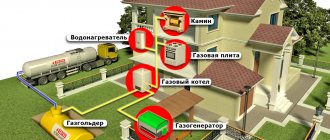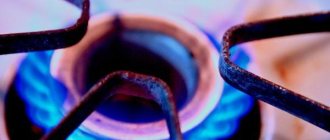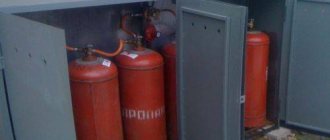Tariffs for utilities, including gas, are regularly rising. Owners of private houses with gas heating or apartments with installed gas boilers for hot water bear especially high costs. But if you follow some recommendations and tips, you can easily reduce costs by 25-30%. In this article we will look at how to save on gas in a private house and apartment.
How to save gas at home
Install a gas meter. With this device, you will be able to regularly monitor gas consumption, and will be able to analyze, reduce and optimize costs. If gas consumption is high and a gas stove is actively used, use devices marked G-1.6. If you have a gas water heater, a model with G-2.5 ratings is suitable.
The numbers in the meter marking indicate the minimum throughput of the device. The G-1.6 meter passes 1.6-2.5 m3 of gas, G-2.5 passes 2.5-4 m3, and so on.
When using a gas boiler to heat water, install an economical shower head and faucet. It is more economical to wash in the shower than in a filled bath. The shower uses 80 liters of water in five minutes. This volume is not enough to fill even half of a standard bathtub.
To wash dishes, it is better to fill the sink with water and wash the items in this water. A suitable option would be to use a sink with two trays, where you wash dishes in one and rinse them in clean water in the other. These tips will help not only reduce gas costs, but also save water in your home or apartment.
Here is Alexey's opinion
The example is simple. Two identical houses, standing at a distance of 200 m from each other (built according to the same design) windows, walls, roof, etc. In the late 60s and early 70s this was very STRICT.
In the first there is a modern wall-mounted heating boiler (selected according to power, with modern burners), in the second there is an old solid fuel boiler, from the early 90s, with old AZOVMASH burners - and lo and behold, it consumes less gas (measurements were taken at night, when all household members they sleep and no one uses the stoves or speakers. AND THE FOCUS IS THE NEXT!!!
All boilers are designed on the principle that the burner heats the water to a certain temperature and turns off. To reduce gas consumption costs, some manufacturers, such as BOSCH, VYLOND, etc., reduce the thickness of heat exchangers; some use cast iron or copper, materials with good thermal conductivity. But, I apologize for the EXPRESSION: BULLSHIT - FLY, none of them thought about the fact that when the water cools down to a certain temperature, the burners light up and they gas at such a speed - which is many times higher than the rate of heat absorption by the heat exchanger and a bunch of our money goes down the drain. And on the old boiler, the lights barely burn (this is achieved by a gas supply valve installed in front of the thermostat), less than the flame of a match. And the heat exchanger manages to absorb more heat.
The conclusion is simple: longer, but barely burning burners provide the same amount of heat, but consume less gas than modern HORNING - “GARING” burners. And when will gas equipment manufacturers pay attention to this?
And one more tip - saving AWESOME money. Open any instructions for gas boilers and you will read that the temperature of the burned gases escaping into the chimney is 110 degrees. And in many regions of our vast country, the heating season lasts half a year. Oh, just imagine that after the boiler, on the exhaust gases, you can install a boiler - and lo and behold, YOU will receive hot water for HALF a year, which will not affect the boiler in any way.
Saving gas on a gas stove
Pay special attention to saving gas when using a gas stove. Adjust the power of the stove burner, and after boiling, reduce the burner to minimum. Use less water when cooking vegetables. They will cook even if they are not completely covered with water. By the way, recommendations for saving gas when cooking on a stove will also help save electricity when using an electric stove.
When cooking, be sure to close the lid tightly, then gas consumption will decrease several times. Do not leave the lid open or half-open. In both cases, gas consumption is equally large. Do not use a gas oven to cook small dishes. Cooking on a burner is much more economical.
Choose pots and pans with thick, flat bottoms that will ensure even and quick heating. In addition, the bottom of the products must correspond to the diameter of the burner. Do not use enameled, aluminum or Teflon-coated utensils for cooking, as they are not economical. A suitable solution would be stainless materials. How to choose a stainless steel pan, see here.
How to save on gas heating
In a private home, gas consumption is mainly used for heating. Gas heating is an environmentally friendly, affordable, economical and efficient option for heating a country house. Therefore, if there is a gas pipeline near the land, most choose this method.
The only drawback of this system is the increased fire and explosion hazard. Therefore, only professional craftsmen should install gas equipment. And after installation, the relevant employees must periodically check the operation of the device.
To save gas when heating, you need to insulate your house as much as possible. Then the heat will not leave the room for a long time. Heat escapes through the roof, windows and doors, walls and floors. In addition, a small amount of heat is lost through ventilation. In this case, it is important to reliably insulate the attic, walls and floors, windows and doors using high-quality materials.
Double-glazed windows and foil reflective insulation, which not only retains heat, but also reflects back into the room, will help you save gas with gas heating. Experts recommend installing a reflective screen between the radiator and the wall. We offer a few more tricks that will help you save on heating.
Comfortable temperature
First, let's decide what temperature needs to be maintained in the house to make it comfortable to live in. Experts believe that the norm is approximately 25 degrees Celsius.
In this mode, heating systems consume one hundred percent of gas. How to reduce this norm?
It is believed that we do not have many ways to save gas. One option is to lower the temperature. If you lower the bar to 17 degrees Celsius, the heating system will consume only 68 percent of gas.
The savings are significant, but the temperature is uncomfortable for living. If we take into account that a maximum temperature of 25 degrees Celsius is not needed all the time, then this fact can already be used. For example, you can reduce the temperature in the house to 17 degrees Celsius at night and during the day when no one is home
. This will allow 78 percent of gas to be consumed.
Since the heating system will be running at full power most of the time on weekends, only 81 percent of the gas will be consumed on average during the week
. Depending on gas tariffs, residents will be able to save more than a thousand rubles in a year.
Seven ways to save gas heating
- Reduce the heating temperature by 2-3 degrees. This is an unnoticeable difference, and you can reduce costs;
- Automate your heating system. Installation costs with active gas consumption will pay off within the first 1.5-2 years of use. With normal use - within three years;
- Install thermal heads on each battery and radiator. This will allow you to regulate the heating temperature separately in each room and reduce costs by 15-20%. You don't heat all rooms equally. So, in the pantry, garage, gym and other similar rooms, use a low temperature;
- Additionally, install a hydraulic arrow on the boiler piping with a pump that regulates the frequency. This will give 20% savings;
- Connect a room chronometric thermostat and you can reduce gas consumption by 15-35%;
- Insulate cold bridges. These are corners and ceilings, cracks and seams. In wooden houses, cold can enter between the crowns, so it is important to make high-quality inter-crown insulation. Don't forget about insulating walls, ceilings and floors, windows and doors. As a result, you can increase savings up to 30-50%;
- Choose economical gas condensing boilers for heating. A suitable option would be dual-circuit models that will both heat the house and provide hot water.
Fuel saving devices
There are several options for appliances: Gas Saver, thermostats and condensing boilers.
Gas Saver
It is better to purchase Gas Saver immediately with the purchase of a thermostat. It is a device based on a magnet. It is installed at the base of the pipe where the hose is screwed on.
The principle of operation is that gas molecules passing through the pipe are broken up under the influence of a magnetic field into an ordered structure. In this form, gas is consumed most efficiently.
The device helps save up to 30% fuel.
In addition, the advantages of Gas Saver include:
- no need to monitor the operation of the device;
- its small size will not spoil the interior; in extreme cases, it can be easily decorated;
- installation does not require special skills or experience;
- It's inexpensive.
Types of gas boiler for heating
Today, manufacturers offer a lot of different models of gas boilers. Cost-effectiveness and ease of use, durability and reliability, and installation safety depend on the right choice. Gas heating systems are divided into single- and double-circuit. As we have already said, the second option provides both heating and hot water to the house.
Depending on the type of design and installation, floor and wall models are made. The latter option is optimal for apartments, bathhouses and small houses. They are characterized by light weight and compact dimensions, and are installed directly indoors.
To install floor-standing models, experts advise setting up a separate boiler room. They are suitable for large cottages and heat an area of over 200 square meters, are reliable, durable and have a long service life.
A gas boiler is available with an open or closed combustion chamber. The first products are the simplest and most affordable with quiet operation. They require the installation of a full chimney. Models with a closed chamber are characterized by increased safety and operation without a chimney. However, they make a lot of noise.
Construction of a wall-mounted gas boiler: 1 - smoke exhaust fan; 2 — NTC DHW temperature sensor; 3 — stainless steel burner; 4 - ionization electrode for flame control; 5 — ignition electrodes; 6 - magnetic anti-scale device; 7 — DHW water flow sensor (turbine); 8 — cold air blocking/excess draft regulator (version F); 9 — control of combustion products removal (pressure switch); 10 — safety thermostat; 11 — NTC heating temperature sensor; 12 - closed expansion tank; 13 — pressure sensor in the heating system; 14 - 3-speed circulation pump; 15 - automatic bypass; 16 — tap for replenishment and filling; 17 - safety relief valve 3 bar; 18 — control of combustion products removal (thermal sensor).
How to choose an economical gas boiler
- Choose modern condensing boilers with a closed combustion chamber. This is powerful and safe equipment with an efficiency of over 95%, which will quickly heat the house and lead to a reduction in gas consumption in a private home;
- Choose models with a closed combustion chamber for installation in a separate boiler room; they will be too noisy in the house. When installing devices with an open chamber, be sure to provide the necessary safety measures;
- The more passages for fuel combustion products are provided in the design, the more efficient and economical the boiler;
- Pay attention to the material of manufacture. Boilers are made of copper, steel and cast iron. The latest materials are the most durable and reliable;
- Heat a private house for country living and large cottages with a floor-standing boiler. For a cottage, bathhouse or garage, use wall-mounted models.
A clear example of saving gas in a car
Let me take a common example. I'm sure it will be clearer to many. Let's take a car. It has a huge number of systems. There is a huge system - the engine. The engine has a large power supply system, that is, the one that supplies gasoline to the combustion chambers. All our lives we have had cars that used a carburetor for this purpose. It was a fairly high-tech thing, debugged over the years, and which, in general, worked well and suited everyone.
But out of the blue, for some reason unknown to me, they stopped installing carburetors on cars and began installing injectors. And what, please tell me, has gasoline savings increased? Has your car consumed less fuel per 100 km? But here the question remains open. Personally, I didn’t notice any savings. I just noticed that the system as a whole has become more complex and now the computer is giving me misfires and I don’t know what to do about it and where they came from. And most importantly, I don’t know how to fix it and what to change. The analogy with your question, it seems to me, is very close.
But let's deal with it with a cold head, so to speak. What determines gas mileage in a car? From the manufacturability of the injection system? Yes! But to a very small extent. There are other things on which savings depend much more strongly. For example, the quality of the gasoline itself, the gas distribution system, the condition of the transmission, by the way, again the condition of the road, its slope, wind direction, driving style and many, many other factors.
How to save gasoline? I think we need to start with something very significant. For example, with correction of driving style. Then replace the body with a more streamlined one. Then move on to measures to reduce friction in the transmission, then to increasing engine efficiency while simultaneously reducing cylinder volume, then to reducing total weight.
The injector makes a mixture of gasoline and air. Moreover, both in the case of a carburetor and in the case of an injector, this mixture is absolutely the same. It seems that for 1 kilogram of gasoline there are 14 kilograms of air. Both devices make this mixture and cope with the task quite well. Well, of course, direct injection is more efficient, but by such a tiny fraction that it’s not worth talking about.
What is worth talking about? In this case, we should talk about the greater environmental friendliness of the car and the consumer convenience that the use of an injector provides compared to a carburetor.
How to save money on a gas boiler
Automate your gas heating system. For this purpose, various fuel supply control devices are installed. These are air temperature sensors inside and outside the house. This thermostat independently regulates the temperature of the water in the system and will avoid excessive heating of the coolant (water). As a result, the boiler turns on less often and gas consumption decreases.
Special thermostats with programs will not only allow you to turn off the boiler when the temperature has risen to the set temperature. It independently turns on or off the device according to a given program. For example, at night you can set the temperature to cool.
When installing thermal heads on the battery, you will be able to control and set the heat temperature in each individual room. For non-residential rooms, use a lower temperature.
If you configure the system correctly and select the temperature wisely, you can save up to 10-30% on gas consumption. In addition, the automated installation allows you to adjust the mode with one button. You don’t have to go to the boiler every time, which makes the design convenient, practical and functional.
In addition, pumps and air conditioners are installed to save money. Pumps ensure efficient transfer of coolant along the circuit and improve heat circulation. Conditioner is suitable as a temporary solution and is only used in spring or autumn. We learned how to save gas. And how to save electricity, see the link.











